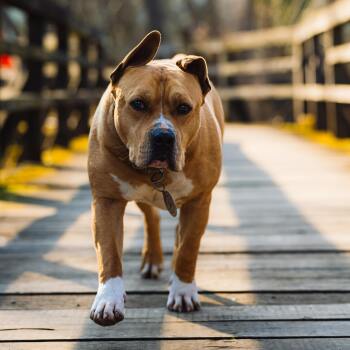American Staffordshire Terriers

A Powerhouse of Personality and Loyalty
Living with an American Staffordshire Terrier is anything but ordinary. These compact canines bring the whole package: strength, smarts, and a big, lovable heart. Whether you know them as AmStaffs or lovingly call them Pit Bulls, one thing’s for sure—they’re unforgettable companions.
Why You Love Your AmStaff
- Cuddle Champions: Known for their affectionate streak, they’re always up for a snuggle session.
- People-Pleasers: Naturally social and eager to win your praise.
- Brains + Brawn: Smart, attentive, and fast learners when trained with consistency and positivity.
- Apartment-Approved: Their size and temperament make them great roommates in smaller spaces.
- Low-Maintenance Grooming: Their sleek, short coat is easy to keep clean and shiny.
A Few Things to Keep in Mind
- Weight Watchers Needed: They’re food lovers, so portion control and daily exercise are a must.
- Early Training is Essential: Socializing your pup young builds confidence and reduces unwanted behaviors.
- Territorial Tendencies: Without proper training, they may become protective of their space.
- Prey Drive Potential: Smaller animals may trigger their chase instincts—training can help, but supervision is key.
- Kid-Friendly… With Awareness: Most AmStaffs love people, but like any dog, they need monitoring around children.
With structured routines, daily playtime, and clear boundaries, AmStaffs thrive in nearly any home setup.
A Little History
This breed’s story began in the 1800s, crossing the Atlantic with immigrants from the UK and Ireland. Once in America, these dogs were selectively bred for strength and presence. Originally used on farms and in early sporting events, today’s American Staffordshire Terrier is a loyal, well-rounded companion that’s earned a place in families around the world.
Lifespan & Vital Stats
These dogs are generally robust, often living 12–14 years with proper care. Still, they’re predisposed to some health concerns—early diagnosis and proactive wellness visits are key.
Common Health Conditions in AmStaffs
- Joint Health: Hip & Elbow Dysplasia— Signs include stiffness or limping due to abnormal joint formation. X-rays can confirm the diagnosis, and managing weight along with exercise can ease discomfort. In severe cases, surgery may be needed.
- Kneecap Trouble: Patellar Luxation— You might notice your dog hopping or holding one leg up. That could mean the kneecap has slipped. Mild cases can be managed with joint supplements, while more serious cases may require surgery.
- Hormonal Imbalance: Hypothyroidism— Dry skin, behavior changes, and sudden weight gain could all point to low thyroid hormone levels. Blood tests confirm it, and treatment is simple—a daily pill keeps symptoms in check.
- Allergy Season, Every Season: Atopy— Pollen, dust, and even certain foods can cause itchy skin, especially on the feet, belly, and ears. Thankfully, there are many medications and skincare routines to help ease the discomfort.
- Mite Overload: Demodectic Mange— All dogs have mites, but some Pits may develop excessive populations that lead to hair loss or irritated skin. Vets can help manage it, and many pups outgrow it as their immune system matures.
- Zinc Deficiency: Zinc-Responsive Dermatosis— Red, crusty skin around the face or paws could signal this issue. A vet-prescribed zinc supplement usually clears things up quickly.
- Fish-Scale Skin: Ichthyosis— This inherited skin disorder causes thick, flaky patches. While there’s no cure, medicated baths and fish oil supplements can help. Genetic testing is useful before breeding.
- Nervous System Risks: NCL— Neuronal Ceroid Lipofuscinosis (NCL) is a serious neurodegenerative condition. Symptoms show up early—often before age 3—and can include weakness, disorientation, or even vision problems. There’s currently no cure.
- Coordination Concerns: Cerebellar Abiotrophy— If your dog seems off-balance or uncoordinated, this inherited neurological disease may be the cause. It typically appears in puppies and unfortunately has no effective treatment.
- Urinary Stones— AmStaffs are prone to uric acid buildup, which can form painful bladder or kidney stones. DNA tests can identify risks early, and special diets help reduce the chance of stone formation.
- Cleft Lip or Palate— Some pups are born with mild to severe deformities of the mouth. While minor cases may go unnoticed, serious defects can interfere with eating and require surgical correction.
- Eye Health: Progressive Retinal Atrophy (PRA)— This inherited eye disease causes gradual vision loss and eventual blindness. It’s painless, and genetic testing can determine your dog’s risk before symptoms begin.
- Parvovirus Protection— AmStaffs are particularly vulnerable to parvo—a dangerous and contagious virus. Puppies should receive an extra booster after their core vaccines, followed by annual boosters to keep them safe.
Big Personality, Big Love
AmStaffs are confident, affectionate dogs who form strong bonds with their humans. With proper care, a little structure, and a lot of love, they grow into loyal companions that fill your home with joy (and probably a few snores on the couch).
Ready to Learn More? We’re Here to Help!


